
Most of the afternoon I wasn’t able to see much of anything through the open window of my pop-up blind. The prevailing wind required that I position myself on the eastern edge of an alfalfa field to prevent the deer from winding me, but that meant I was facing directly into the setting sun. I could, however, see four or five dark forms in the halo of light, and one of those forms looked much larger than the others.
It was another half-hour before I could clearly see the deer in the field, and the larger form was indeed a buck. His heavy body and dark color indicated that he was a mature deer, and he split his time that afternoon between feeding on alfalfa and checking nearby does. When the buck stopped feeding to chase a doe into a patch of live oaks and junipers, he offered a clear broadside shot at 120 yards. I gave the deer one last look and felt certain he was at least five years of age. When the crosshairs settled just aft of the buck’s shoulder I squeezed off a shot.
There was an audible bullet strike and the buck plowed forward into the thicket, clearly hit hard. The does stood at attention in the alfalfa field as I exited the blind and, one by one, they bounced into the surrounding forests with tails high. I found the buck where I thought he’d be, piled up under a low-growing juniper.
On many hunts that would be the end of the story—and from there the deer would be field-dressed, we’d snap a few in-field pictures then the animal would be sent off to the processor. At an Outdoor Solutions field-to-table event, however, killing the animal is just the beginning of the process. Today I’d have to field-dress the buck then hang and skin him, and under the careful eye of a master wild-game chef, butcher the deer and learn how to prepare each particular cut of meat from the animal. By the time I left Texas I had coolers full of fresh deer roasts, steaks, burger and sausage, all of which I processed myself. Perhaps more importantly, I had an intimate understanding of how to fully process my own animal after killing it in the field.
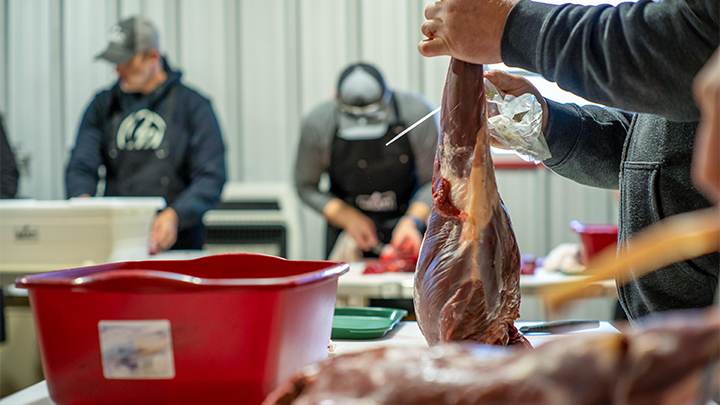
The Field-to-Table Concept
In 2003, Greg Ray started an outfitting business in Kansas he called Outdoor Solutions. By 2012, Ray realized many hunters weren’t prepared to make the long shots required when hunting some Western big game, so he added a long-range shooting component to his hunts. Shortly thereafter, Ray was engaged in a campfire discussion with writer Ian Harrison when Harrison brought up the idea of starting a magazine solely devoted to the topic of cooking wild game—and Ray realized it might make sense to add a cooking component to the shooting and hunting courses Outdoor Solutions already offered. Seven years later, Ray heard Harrison promoting his brand-new magazine Carnivore on a podcast, and he was prompted to call Harrison to further discuss the idea of adding a wild-game butchering and cooking element to Outdoor Solutions’ long-range shooting schools and hunts.
“I added the field-to-table component to our events for selfish reasons,” Ray says. He realized that his own experience allowed him to quarter an animal for packing, but beyond that, he had no practical knowledge of how to butcher game. Ray wanted to learn himself, so he sought input from wild-game chefs, chiefly Albert Wutsch, a certified culinary instructor who had served as culinary department chairperson at Indiana University of Pennsylvania until his retirement in 2015. Chef Wutsch, who is both a longtime hunter and a professional chef, was the ideal person to help Ray understand what a field-to-table curriculum should look like and what these classes would entail.
What Ray classified as “selfish” reasons were, in reality, more of a realization that hunters who did not know how to properly handle the animal from the time of its take in the field until it’s consumed were at the mercy of butchers and game processors. In the spring of 2019, Outdoor Solutions offered its first field-to-table event where students learn to shoot accurately at long range, take an animal then butcher and cook that animal with input and guidance from a professionally trained chef. That event sold out within an hour.
Ray’s courses were a major success, but he noticed something interesting about the participants: many had no hunting experience.
“We found there are two main reasons non-hunters who are interested in the sport don’t start hunting on their own,” Ray said. “First, they find the sport intimidating, and second, they don’t know anyone who hunts that can help them.”
In 2020 fully half of Ray’s Field-to-Table students had never hunted before, and by the end of the five-day course they could not only shoot a rifle but field-dress and butcher their animal and cook complex wild-game recipes. During just the first quarter of 2021, Ray has seen 17 brand-new hunters complete his course. And, based on current trends, there’s no indication of a drop-off in the number of students interested in field-to-table events.
The Breakdown
There are many resources available for the hunter who wants to learn to butcher his or her own deer. Online videos abound, or you could simply ask the advice of a hunter who butchers his own game. But I don’t think any of those methods are as effective as the hands-on education hunters receive at a field-to-table event. The day after I took my buck, I stood staring at the whitetail’s skinned, hanging carcass while Chef Wutsch guided me through my initial cuts, which are known in the culinary sphere as primal cuts. I followed his directions closely. I was careful to cut where he cut on his deer and to never get too far ahead.
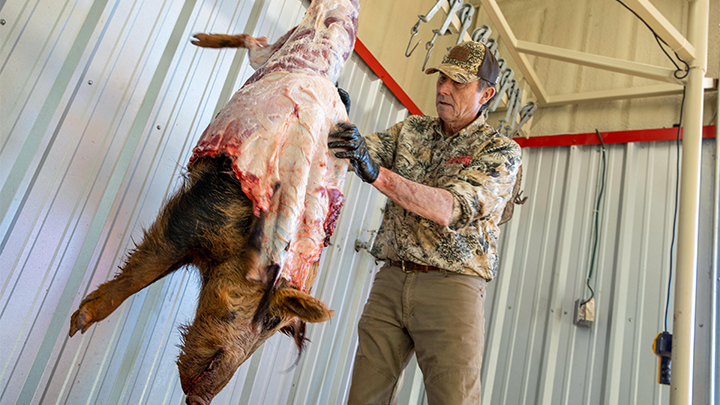
Like most other big-game hunters, I assumed I had some understanding of how to butcher an animal. After all, I have quartered elk and packed whole caribou carcasses out of the field. But the Outdoor Solutions field-to-table event was the first time I’d ever learned the how and why of each cut I made. Chef Wutsch walked me through the proper primal cuts on my deer and, as he pointed out, a deer breaks down in very much the same way as an elk, a moose, a bear, boar or rabbit. The basic tenets of proper butchering are the same for all mammal species, so even though I learned the butchering process using my deer and feral hog I’d shot as part of the course, I could apply the same principles I was learning to elk, pronghorn or any other animal.
Chef Wutsch was clear on one point: Preparing delicious wild-game dishes begins with proper handling of the animal in the field, which isn’t particularly hard so long as you understand what constitutes proper handling.
“I’ve seen hunters drag harvested animals behind a four-wheeler and peel off the hair,” said Wutsch. “I’ve seen game animals that weren’t dressed and cooled quickly on warm days. I’ve seen people that let their meat get covered in hair and dirt. You’re never going to get that meat to taste good.” One mistake he sees frequently is hunters who wash the body cavity of an animal with cold water.
“That water promotes bacterial growth,” says Wutsch. “Keep the meat as clean and dry as possible.”
Once I removed the backstraps and tenderloins from my deer and had separated all four quarters from the body, it was time to begin cutting steaks. Guitar Ranches, where we were hunting, offers a complete butcher shop that doubles as a classroom for Outdoor Solutions students, so I had plenty of space to make my cuts and a walk-in freezer nearby when I needed to store meat. The large stainless steel tables, the proper tools and the cold space all made the process much easier than trying to learn at home on a small folding table. Greg Ray partnered with “MEAT! Your Maker” for our hunt. MEAT! offers a variety of processing equipment that you’ll want to add to your field-to-table toolkit (see sidebar). All their tools are made to survive in commercial kitchens. For the new student, the right tools and the right setting make butchering much easier.
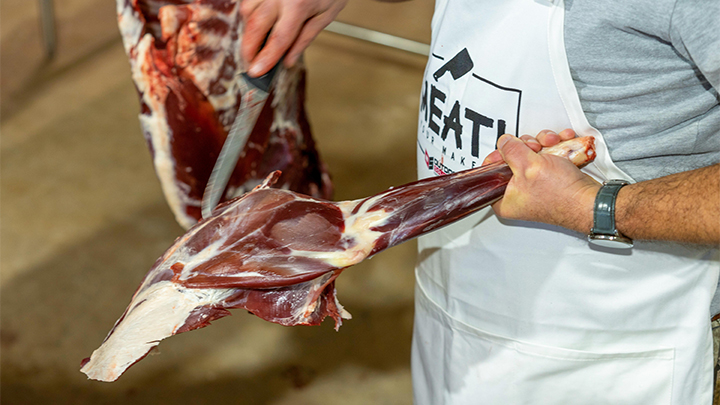
In truth, butchering deer, hogs and other midsized game is not particularly difficult. It is, however, important that you learn it from someone who understands how meat needs to be handled. Making the primal cuts on a deer is straightforward and familiar to anyone who has ever quartered big game, but identifying and isolating specific cuts like the eye of round and flat iron steak requires training. As we cut and trimmed each steak and ran it through the MEAT! vacuum sealer, I made shorthand notes on each package to remind me how to cook each cut based on Chef Wutsch’s recommendations. By the time I had finished packing my deer, I had cooking instructions for the entire animal jotted on plastic bags.
After cutting the steaks, our class used the tools MEAT! provided to make jerky, burger and sausage, and when that was completed my entire deer was packed, vacuum-sealed and frozen in anticipation of my drive home—all, that is, except for a handful of sausages and steaks I’d left out for the evening meal. The final step in the field-to-table experience requires students to prepare and serve a wild game dish. Not surprisingly, the wild game menu Chef Albert Wutsch constructed was far more complex than simple spaghetti or chili. Instead, my team of two hunters created a sausage sampler appetizer followed by crispy feral boar wonton tacos with Asian slaw.
Even if you feel you already know how to shoot and butcher game, I suggest you attend a field-to-table course because over the duration of the class you’ll encounter some aspect of the shooting/hunting/butchering/cooking process that will challenge you. My challenge was meal prep. I am competent in a kitchen, but I’m more of a spaghetti and chili kind of guy myself. I started to flounder when it came time to prepare and plate the night’s meal. Chef Wutsch and the kitchen staff at Guitar Ranches guided me through the process, though, and eventually what I served looked very much like the photo that Wutsch included with the menu card. The meal tasted very good, actually, and I mention that not so much to pat myself on the back (I merely did what I was told and my many mistakes were overlooked and corrected) but to make clear that any aspect of the field-to-table process intimidates you, be it shooting, field-dressing, butchering, processing or meal preparation, can instead become an opportunity to improve your skills.
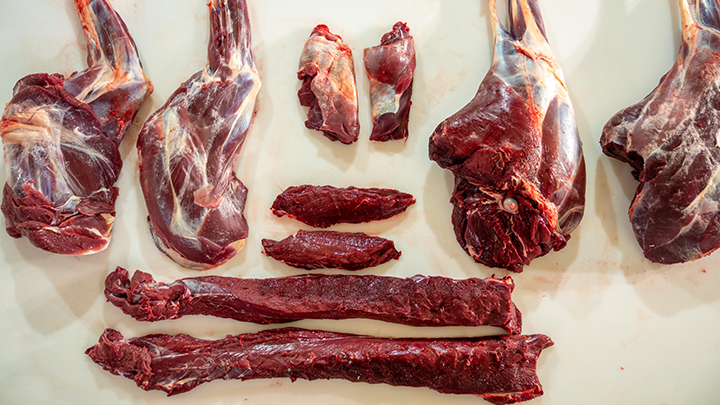
Most importantly, students learn the proper way to care for wild game meat, a process that begins by making the right shot to minimize suffering and maximize the amount of quality meat you remove from the animal. Greg Ray told me he’s particularly proud that Outdoor Solutions’ field-to-table experience helps hunters manage their own image, which is true. These courses demonstrate that the primary objective of hunting is procuring meat. In that respect, Outdoor Solutions’ Field-to-Table courses offer even non-hunters a unique opportunity to familiarize themselves with every aspect of the sport even if they have no previous experience in the field.
By the time I left Texas, I had three large coolers filled with hog and deer meat, but more than that I came away from the hunt with important skills I didn’t possess when I arrived. I also came away with a critical eye for how my game meat should be handled, either by myself or by a butcher. Hunters take pride in being self-reliant, but we’re only truly self-reliant if we can manage the process from the time the animal is taken until the time it is in the freezer. That used to be knowledge that was passed down from one generation to the next, but now even if none of your family members ever hunted, you, too, can take part in one of humankind’s oldest traditions.
Hunters may book a field-to-table adventure with Greg Ray's Outdoor Solutions at outdoorsolutionscorp.com.
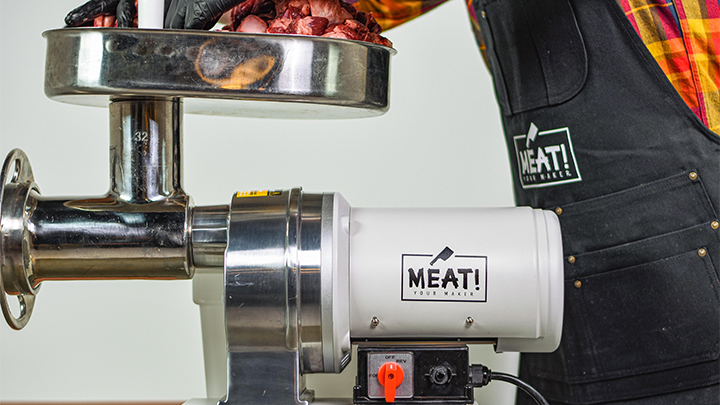
MEAT! for Home Butchers
MEAT! Your Maker 1.5 HP Grinder: There is cheaper gear out there, but if you’re serious about processing a whole deer (or multiple deer, or an elk) you want quality equipment. MEAT!’s grinder is built to industrial standards. Stainless construction and heavy-duty hardware ensures it is up to any task, and since it can process up to 18 pounds of meat per minute you can grind an entire whitetail in less than 10 minutes. It also disassembles easily for routine cleaning. MSRP: $699.
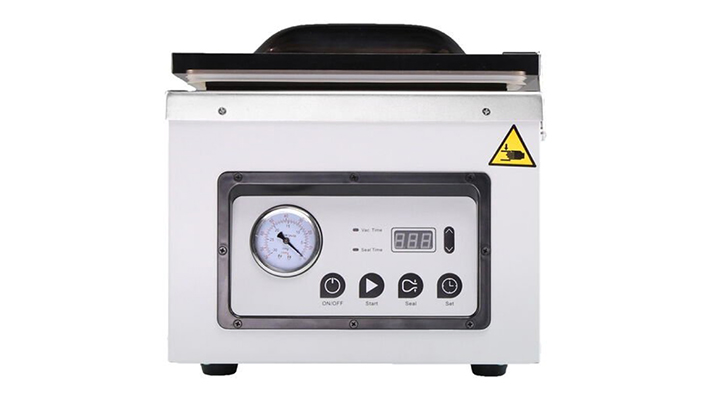
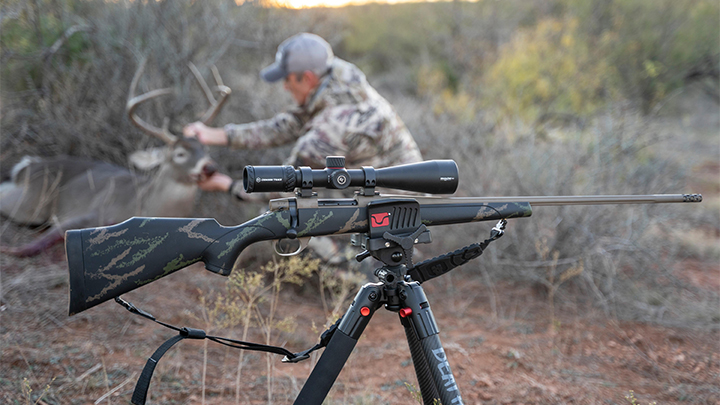
Texas Field Gear
Weatherby Vanguard High Country: The Weatherby Vanguard bolt-action rifle I used at Guitar Ranches features a black polymer stock with tan and green accents and a flat dark earth Cerakote finish on its receiver and fluted, threaded barrel. These rifles are available in a range of calibers from .257 Weatherby Magnum to .300 Weatherby Magnum, and Weatherby promises sub-MOA accuracy. The High Country rifle I used in Texas was chambered in 6.5 Creedmoor and shot well under an inch for three shots at 100 yards. MSRP: $999; weatherby.com.



































